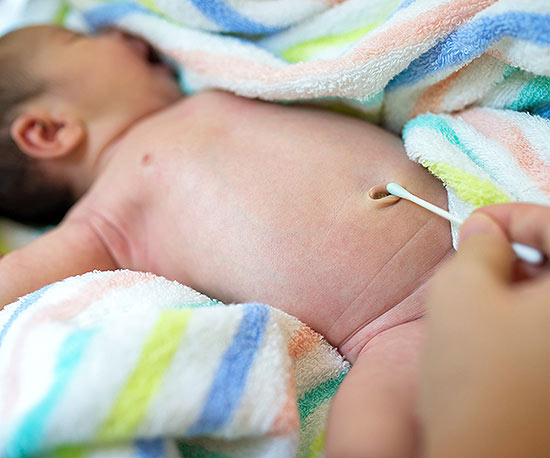The umbilical cord connects the baby to the mother during the nine months of pregnancy. Immediately after birth, the umbilical cord is cut and clamped by the doctor. A small stump remains which normally falls off within a couple of days. In most cases, the belly button in newborn heals without any problem. However, in certain cases, complications occur such as a discharge from the belly button. During the healing process, some discharge is considered as normal, but in some cases, this indicates an infection. Knowing the difference between the baby belly button discharges is important in order to know when medical help is necessary.

What Does Baby Belly Button Discharge Mean?
Normal Discharge
When the umbilical cord falls off, a slight bleeding is considered normal. This is more likely to occur in cases when the umbilical cord gets pulled off totally or partially. A yellowish or greenish discharge in small amounts is also considered normal, as long as it does not have any odor. Around the umbilical cord stump, some mucus presence is normal before the stump falls off, or even a couple of days later after the stump is gone.
Abnormal Discharge
Continuous bleeding from the baby belly button should make you concern. Also, any yellowish or whitish discharge which is also accompanied by a foul smell should make you worry. These are signs of an infection, and especially the presence of pus in the belly button. Any baby belly button discharge in large amounts, regardless if it is mucus, blood, or pus needs medical attention and the right treatment.
Other Symptoms
Other symptoms that you could notice in a newborn around the belly button include swelling, redness, high fever, change in how the newborn acts, etc. If you notice any of the above-mentioned symptoms together with discharge, seek immediate medical help as these are all signs of an infection.
How to Deal With Belly Button Infection?
How to Take Care of Your Newborn?
- Taking care of your newborn can be quite a challenge, especially for first-time moms. This is especially true when it comes to taking care of the newborn’s belly button and mostly during the healing time when the belly button stump has not fallen off already. Once the belly button stump falls off, taking care of the newborn’s belly button becomes a lot easier.
- Cleaning the belly button is very important. Make sure to clean away any dried secretion twice daily. For this purpose, use a cotton swab. A damp cloth can be used as well. Dry the belly button carefully. Make sure to clean the area well, and also push down the skin around the belly button to clean it correctly and thoroughly.
- In cases when an infection is present and there is baby belly button discharge, antibiotic ointments are necessary. You should apply the antibiotic ointment twice daily, after cleaning the area carefully first.
- For a faster recovery, make sure to fold the diaper down below the belly button area until the umbilical cord stump falls off and the belly button heals as air exposure and dryness speed up the recovery process.
- Once the infection is resolved, you should continue with the natural drying process, as normal cords don’t need any special treatment.
- One of the mistakes that mothers often do is that they apply talcum powder on the belly button area. However, talcum powder is not recommended as it irritates the tissue.
When to Seek Medical Help?
You should seek immediate medical help in the following cases:
- Your newborn has a fever higher than 38 degrees Celsius or under 36 degrees Celsius.
- Your newborn acts sick.
- You notice blisters or pimples around the belly button area of your newborn.
- You notice red streaks on the skin around the belly button area of your newborn.
- The belly button area is not dry and clean even after 2 days of treatment.
More Things to Know About Caring Baby’s Umbilical Stump
When Will the Umbilical Stump of My Newborn Fall Off?
Usually, it takes about 5 to 15 days for your newborn’s umbilical stump to fall off. If the umbilical stump is kept dry and clean, the recovery process will be faster. The stump during this process changes its color from yellowish to green, brown and eventually black until it falls off on its own. Don’t pull the stump as it will fall off by itself.
How to Take Care of My Newborn’s Umbilical Stump?
The most important thing is to keep your newborn’s umbilical stump clean and dry in order to prevent any infections. Make sure to wash your hands every time before taking care of the umbilical cord area, as well as after every diaper change. Make sure to fold down the diaper so the air can get to the cord. Wear your newborn in loose clothing as well.
If the umbilical stump gets wet during a bath, this does not mean that the healing process will get longer as long as you carefully dry the area afterward. However, if the area remains wet, there is a great possibility that it can get infected.
There is no need to use an antiseptic on the umbilical stump as long as you keep the area dry and clean. Antiseptics can prolong the recovery process and usually the umbilical stump takes longer to fall off in these cases.
How Long Does It Take for the Newborn’s Belly Button to Heal?
After the umbilical stump falls off, a small wound will remain for a couple of days. Usually, it will take about 7 to 10 days for the belly button area to completely heal. Once the wound is completely healed, it will become your baby’s belly button. Some blood in the diaper is normal during this time, which should not frighten you.